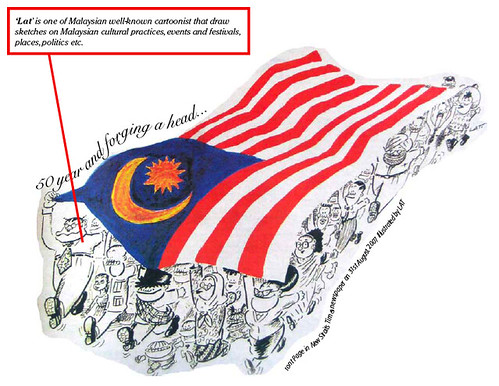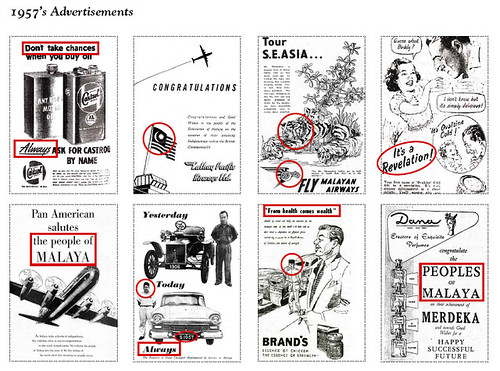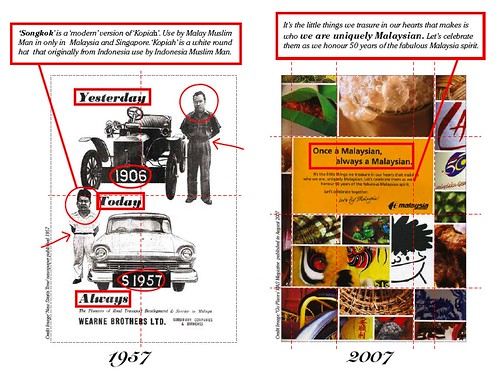I’m presenting a paper at a 17th Biennial Conference of Asian Studies Associations of Australia (ASAA). It at Albert Park Hotel, in St Kilda, Melbourne.
In this paper I will discuss about the earliest project in the beginning of my PhD, the Online Forum and www.malaysianidentity.com is the case study of this paper. As my PhD is a practice-based design research project, it is challenging to explain it to the non-design background what is design research and what is practice-based research. Here’s the abstract of my paper. If you interested to read the whole paper, please do email me.
Can an online discussion be used as a new research practice? A case study www.malaysianidentity.com
Nurul Rahman
With the rise of web 2.0, and collaborative web sites and communication platforms, there is the temptation and the possibility of utilising innovative technology for research methods and practices.
As part of a practice-based design PhD research project, I used an online discussion forum as an environment to enable focus group discussions. The aim was to gather together a selection of research participants (artists and designers) involved in creative fields, to start a conversation, and explore ideas about, Malaysian identity and its representations within cultural artifacts. I facilitated this discussion, exploring particular topics; and through the use of open-ended questions and threads within the forum, encouraged participants to present their ideas and engage with others.
This paper will discuss how an online tool can be used within a research project to experiment and confront ideas, to find new directions for investigation or to have a general discussion about a specific subject with research participants who are located in diverse international locations, asynchronously.
The forum malaysianidentity.com will be used as a case study to explore the advantages and challenges such a solution may present.
Full paper

Can online discussion be used as a new research practices? by Nurul Rahman is licensed under a Creative Commons Attribution-Noncommercial-No Derivative Works 3.0 Unported License.
Talking to Yoko about my research always helped me in putting my puzzle together. Yoko asked me to visualized my research using a metaphorical methods. Because Im still researching and not so sure weather the words Im using is what Im really mean, Yoko suggested me to either leave it blank or give it a name. Leaving it blank is not very easy for me as ˜blank for me means nothing, and it will confuse me later on. So this is how I decided to do it taking on board what Yoko suggested me to try on. I will use the metaphorical idea of ˜cake. Before I continue this idea of cake, I would like to define some parts in my research that I will relates with using the metaphorical of ˜cake.
What are my key questions in my research?
My research interested in the contributions of design, particularly communication design and it close relations to the constructions of national and cultural identity. Although, both national and cultural identity are two different things but both connected to each other closely. Without one, the other will not mean anything. Thinking what comes first in identity is like thinking what came first in chicken and eggs. Both inform each other constantly. This leads to the question Quest-ce quune nation? What is the nation? Apa itu bangsa? And the next question narrowing it down to subject in my research is about Malaysia which what Im searching for What makes the nation? ˜Apa yang membentuk bangsa?.
Now, I have to admit, these questions is really broad and it is the on going questions that most of the researcher in sociology, anthropologies, media and cultural studies, history etc. have asked in their research until now. My research although it relates very much to the questions that Ive asked before, it is also relates to communication design. In fact my PhD is focusing on the roles of design, particularly communication design in the construction of national and cultural identity. I argued that communication design play a significant roles in the shaping of national and cultural identity. Clearly it is quite obvious but there is not much written about it, the involvement of communication design in the constructions of national and cultural identity, particularly south east asia, such as Malaysia. Which areas in design or what medium in design that Im focusing in is a good questions. And how it contributed, through what medium and what makes it is a strong argument is what Im still investigating.
Back to the attempt of using a metaphorical ways of looking at my research questions ˜What makes the nation? ˜What are the ingredients that shape Malaysian identity, nationally and culturally?. If ˜cake is the Malaysian identity, then what is the ingredient of making that ˜cake? Why is that this cake is claimed uniquely Malaysian? I think what Im doing is questioning the idea of uniqueness in Malaysian identity. Why did Malaysian think that Malaysia is unique? Or not.
If I argued the Malaysian Identity is not unique, because what makes Malaysian Identity is similar to what makes any other countries such as the different in of culture, custom, cuisine, etc. then what is it then? What makes the people (Malaysian) believe that their nation is unique? Theres a lot more in unique than different. Indeed, each nation is different in some ways, lifestyle and culture but is it unique? Is it by using the word unique are strategies to a nation building, or as a way to promote the country? In fact is it part of the country branding to create a belief that the country is special? This is interesting, focusing on the words unique, what are the relation between branding and the nation building?
Unique = being the only one of its kind; unlike anything else, particularly remarkable, special, or unusual.
Is Malaysian unusual? Lets have a look at what different mean?
Different – not the same as another or each other; unlike in nature, form, or quality ; distinct; separate
Therefore it is no longer unique, but it does have ˜________ that somehow makes Malaysian different, that distinguish Malaysia from others, that relates Malaysia to something, could be an object, could be material or immaterial (Dewey pp.? 1938 “ refer to Margolin Experience as a product). What are the relationship between the product and the person, and how it creates the notion of national/cultural identity? What makes a person feel the connection between self and identity? How does the graphic design contribute in the construction of it?
22 August 2008
Memories play a significant part in our day-to-day life. A grand father will past some stories from his past experiences in life to his grand children. Memories could be categorized in different areas, some could be sweet memories, some are sad memories and others could be the unforgettable memories. But some of these memories can be maintained or forgotten depending how important it is, particularly when it relates closely to the development of a country. Stories of the victory and fighting for freedom are mainly the ˜active memories that been used in a country as a way to construct the national identity. Memories can be represented and transformed through writing, photograph, images etc.
Long time ago, writing, printing and speech are the main medium of transmitting the memories. It been used as a way to transform information, history of the past etc. Now a day, where communication mediums are expending borderless with the use of Internet, satellite televisions, images etc, memories now can be share by others around the world. Visual are widely and strongly used as a way to transmit the memories to others.
A story about victory is much more effective if its been view through represented imagery rather than writing. Visual imagery helps to transform the memories to a reality. For example, image of victory scene would be repeated again and again through different medium as a reminder that people have fought for the freedom. It stayed in our memories as part of our cultural memories and soon we will transfer it to our children.
What is called ˜prosthetic memory (Connerton, 2006) when it takes more on the visual forms can sustain the existence of imagined communities as effectively as does, according to Benedit Anderson, the diffusion of printing.
Museums, libraries and national archives are places where the memories particularly national memories are stored. The artifacts that been kept in these place are carefully chosen as it would reflect the national and cultural identity of the people. History of the past have to be told correctly as it is part of the process of shaping the national identity. Collective memories through conversation, visual images and text help in rewriting and re-imagining the past. Repeated images, narrative of visual, symbols and representation through advertisements, popular pop culture magazines, poster etc. are examples of a way to sustained the notion of identity, that could be related to either nationally or culturally.
The relations between images and advertisements and their connection to national and cultural identity.
In the case study of Malaysia and its relation to my research going back to in 1957, through the national Malaya newspaper, most of the advertisements are mainly from the international brand or company such as Shell, Palmolive, Pan American, Bank of America, Qantas etc. They are the one that filled in most of the space for advertisement particularly on the celebration of independences Day. What does this mean? Why in the main national newspaper this kind of advertisement been chosen to be put in? Interestingly, it is seem to me, Malaysia or known as Malaya at that time, is seen as a young nation searching for identity, a way forward, development, growing of economy and social. Therefore, through these advertisements it could inform, educate, or offer the people choices of what they country want to be in future.
Wearne Brothers LTD (1957)
I got this piece of 1957 advertisement from a reprinted New Straits Times newspaper on the 31st August 2008. Its an advertisements for a car company and it is one of the ads that been published in the New Straits Times newspaper for Malaysian Independence Day. Its interesting to see the difference between 50 years from 1906 to 1957 through the ads of a car company. Not only the design and the look of the car that could remind us of the differences in time but also it could also show the growth of economic development in Malaya at that period of time. For me it also indicates that moving forward and better future through car as one of the moving vehicles, the design evolution and the indication of the year as a plat number.
Lets focus on the man standing beside the car. How often did you see a man as a model for a car company? One man standing at the car that dated 1906 as the plate number, wearing a semi-normal clothes with the gesture positioning both of the hands behind the body such as a position that called a ˜resting position such as in the army, point out to me as a position to wait for order. For others, without knowing where this advertisement comes from it is very hard to tell which country origin of both of the standing man.
This advertisement was published in English and it targeted the spectators who are ˜Bumiputra , educated, wealthy and can communicate in English. From my cultural understanding, I recognized this man as a ˜Bumiputra man through his look and the color skin tone. Most Malay have a medium brown tone skin color, compare to Chinese who are very fair close to yellowish cream color, and Indian that have much darker brown from Malay. Although these days it is difficult to recognized each ethnics through their skin colors as there are many intermarriage between each ethnics.
For people who are not familiar with the ˜Bumiputra this man could be from any English spoken country such as Philippine, Pacific island South America, Mexico, etc. He looks like a middle-class man could be a businessman, from a professional background, of perhaps from a government administrative. He is well dressed with his shirt tuck in his pants gave an impression that he could come from a wealthy and educated family background.
The word ˜Yesterday that stated beside him added some extra meaning in this advertisement. Apart from the indication of ˜Yesterday that its from the past, it could be also reminding the spectators of some nostalgic memories or dreams with connection to the car. At that period of time, it is very difficult to own a car because of various reasons mainly financial. Middle class people in the past particularly in 40s to 50s can only afford to have a bicycle or scooter motorbike. Other vehicle such as cars could only be affordable to people who comes from wealthy and high status family background. The date also was stated nicely as a plat number of the car. ˜Yesterday means in 1906 seem to be far away and perhaps its time to move forward.
In the next image that stated the word ˜Today, the same position the man standing beside the car with the plate number dated 1957 which is the year Malaysia gets independence. The layout position look nearly the same except the man in ˜Today was wearing ˜Songkok a Malay men hat. Its also indicates that this man is Muslim. This image is telling me that in 1957, the people in Malaysia are searching for identity by putting the man with his ˜Songkok. Does it telling us that the Malays are the dominant ethnics therefore they are the main authority. Where are the Chinese, Indian and the indigenous? Are they part of Malaysia? Most of the advertisement in Malaysia hardly have an indigenous images, only recently when Malaysia celebrate her 50 years of independence the images of the indigenous starts to appear in most of the advertisements. (Packaging a myth¦refer this to it)







